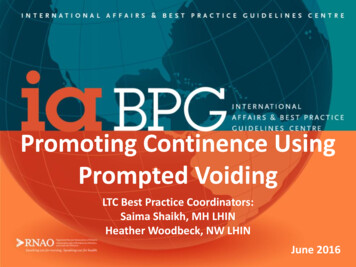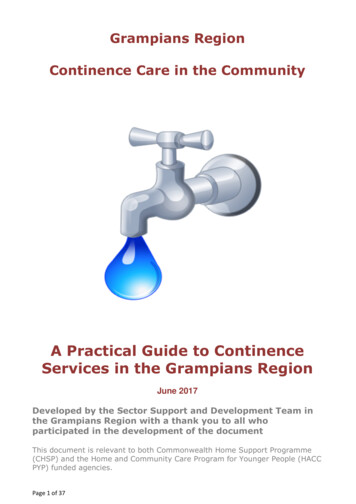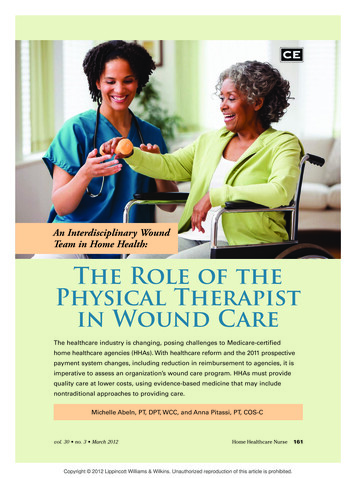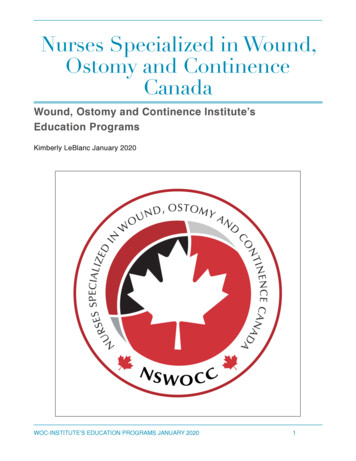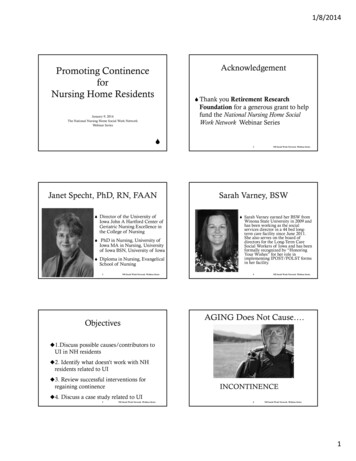
Transcription
1/8/2014AcknowledgementPromoting ContinenceforNursing Home Residents Thank you Retirement ResearchFoundation for a generous grant to helpfund the National Nursing Home SocialWork Network Webinar SeriesJanuary 9, 2014The National Nursing Home Social Work NetworkWebinar Series 2Janet Specht, PhD, RN, FAANSarah Varney, BSW Director of the University of PHOTOIowa John A Hartford Center ofGeriatric Nursing Excellence inthe College of Nursing PhD in Nursing, University ofIowa MA in Nursing, Universityof Iowa BSN, University of Iowa Diploma in Nursing, EvangelicalSchool of Nursing3NH Social Work Network -Webinar SeriesObjectivesNH Social Work Network -Webinar Series Sarah Varney earned her BSW from PhotoWinona State University in 2009 andhas been working as the socialservices director in a 44 bed longterm care facility since June 2011.She also serves on the board ofdirectors for the Long-Term CareSocial Workers of Iowa and has beenformally recognized by “HonoringYour Wishes” for her role inimplementing IPOST/POLST formsin her facility.4NH Social Work Network -Webinar SeriesAGING Does Not Cause . 1.Discuss possible causes/contributors toUI in NH residents 2. Identify what doesn’t work with NHresidents related to UI 3. Review successful interventions forregaining continenceINCONTINENCE 4. Discuss a case study related to UI5NH Social Work Network -Webinar Series6NH Social Work Network -Webinar Series1
1/8/2014DEMENTIA Does NotCause .So What Happens with Aging? Decrease of bladder contractility,INCONTINENCE Decrease in bladder capacity Decrease in the ability to delay voidingThese do NOT cause incontinence but predispose elders to it.7NH Social Work Network -Webinar SeriesSo What Happens withDementia? Impaired mobility Way-finding Planning Interpreting urgeNH Social Work Network -Webinar SeriesContributors to UIDisease or Impairments Diabetes Mobility Surgeries CognitiveImpairment Functional PainProblems Managingclothing &hygiene Infection11NH Social Work Network -Webinar SeriesContributors to UILifestyle FactorsThese can be corrected or modified Impaired cognition affecting98NH Social Work Network -Webinar Series Dehydration Constipation Impaction Obesity Smoking Caffeine intake Environment10NH Social Work Network -Webinar SeriesPhilosophy of TreatmentAcceptance of incontinence as an inevitableconsequence of aging or dementia is amanifestation of discrimination and ageism, andis inconsistent with person-centered care.The problem is with attitudes, knowledge andactions of health care providers, older personsand their families and caregivers.12NH Social Work Network -Webinar Series2
1/8/2014Goal of UI Treatment The goal of treatment is to restoreand promote continence and toimprove the quality of life.13NH Social Work Network -Webinar SeriesConsequencesPhysical Skin infection and breakdown, UTI &sepsis, Falls and FracturesPsychological Guilt, anger, altered self-image,depression, sexual difficultiesSocial Isolation, withdrawal from family &friends, avoidance of social activities,dependence on others, primary reason forplacement in nursing home, decreased qualityof life14Assessment Purpose: Establish Type,Pattern and Consequences of UINH Social Work Network -Webinar SeriesBladder DiaryIndividual’s record of daily bladder activity History Mental StatusEvaluation Social Psychological Environment Bladder Diary Physical Exam PVR FunctionalAssessment15Usefulness: Assessing baseline function Recognizing patterns in person’s bladder behaviors Determining the interventions and the effectivenessof interventionsPromotes continence by helping the caretakers developindividualized scheduled toileting programs whichmimic the person’s normal voiding patterns.NH Social Work Network -Webinar Series16NH Social Work Network -Webinar SeriesWhat doesn’t work Assuming nothing can be done Doing the same thing for all Residents Not including Resident and family in the plan Doing an inadequate assessment prior to startingintervention Failing to consider the psycho social consequencesof UI17NH Social Work Network -Webinar Series18NH Social Work Network -Webinar Series3
1/8/2014What does work?Effective Interventions Early intervention Education of residents, staff, families about UI Measuring effectiveness of treatment Increased sensitivity to the impact of UI onpersons Addressing environmental barriers Encouragement for staff and Residents19NH Social Work Network -Webinar SeriesHabit TrainingHabit training is scheduled toileting on a plannedbasisMatch the voiding intervals to the person’s naturalvoiding scheduleYou can do this with persons who are cognitivelyimpaired as well as those who are not.Evidence: Effectiveness demonstrated in controlledtrials21NH Social Work Network -Webinar Series Habit Training Prompted Voiding Environmental Changes Promotion of Healthy Bladder Habits20NH Social Work Network -Webinar SeriesPrompted VoidingRequires the caregiver to ask the person on an individualizedschedule the need to void, offers assistance, and then offerspraise for successful voiding, Three Primary Behaviors areused each time prompted voiding is initiated:Monitoring-Check pad/incontinence aid, and ask the needto voidPrompting- Every 2-3 hours to void (Individualized)Praising- Person praised for maintaining continence/usingtoiletEvidence: Improves continence in 35-50% of the cognitivelyimpaired and 60-75% of cognitively intact.22Toilet AccessNH Social Work Network -Webinar SeriesHealthy BladderHabitsDistance, ground floor,stairs, height of toiletseat, door to toilet orbathroom (heavy orawkward), large graphicsigns for toilet, Brightbathroom lighting(automatic lights)23NH Social Work Network -Webinar Series24NH Social Work Network -Webinar Series4
1/8/2014Healthy Bladder HabitsLifestyleCase StudyBehavioral Treatments Fluid Intake Bladder Diary Bowel Function Weight Prompted Voiding Smoking Habit Training Mobility and Function Roles of Environment25NH Social Work Network -Webinar SeriesCase StudyCase Study - Perspectives Mr. X has dementia and is incontinent ofboth bowel and bladder. Sometimes he realizes he needs to urinatebut does not remember to use the toilet He has a habit of urinating ininappropriate places– potted plants, trashcans, and common/public areas.27 Other residents bothered by thebehavior Family lives far away, report he wouldbe appalled by this behavior Staff - consider his behaviorunmanageableNH Social Work Network -Webinar Series28Case StudyCase Study Intervention: Preferred outcome: Mr. X no longer urinates in sociallyunacceptable locations Care conference with nurse and social worker Hourly schedule for staff to take Mr. X to thetoilet established (who all is involved? All shifts?) The number of episodes ofincontinence is reduced for Mr. X29NH Social Work Network -Webinar SeriesNH Social Work Network -Webinar Series Consider dressing Mr. X in overalls (concernedthat this may be perceived as a type of restraint -check with Power of Attorney)30NH Social Work Network -Webinar Series5
1/8/2014Case StudyCase StudyResident’scare plan was updated to include that he would be put on an hourly toileting schedule and that staff would dress theresident in overalls, which resident’s family was in agreementwith. Resident’s incidences of incontinence decreased due tobeing able to use the restroom more often and his continenceincreased. Also, when the resident did have the urge to urinate ininappropriate places, he was unable to pull his pants down. Staffalso realized that the resident would become more restless whenhe needed to go to the bathroom, so staff was able to help him tothe restroom when they noticed his increased restlessness.Resident’s incidences of urinating in inappropriate areas also31NH Social Work Network -Webinar Seriesdecreased significantly since he wasbeing toiletedmore often.Resource - journal article Sanders, S., Bern-Klug, M., Specht, J., Mobily,P.R., Bossen, A. (2012). Expanding the role oflong-term care social workers: Assessment andintervention related to urinary incontinence.Journal of Gerontological Social Work, 55:262-281.33 As a facility, we learned that more frequentintervals in toileting schedules helpedminimize episodes of incontinence in ourresidents and actually promoted morecontinence. For the residents in our facilitywho have frequent episodes of incontinence,we started toileting them more often and havereceived similar positive results as this casestudy.32ResourcesWound Ostomy Continence Nurses SocietyNational Office15000 Commerce Parkway, Suite C, Mt. Laurel,NJ 08054888-224-WOCN (9626)http://www.wocn.orgAn international society providing a source ofnetworking and research for nurse’s specializingin enterostomal and continence careNH Social Work Network -Webinar SeriesResourcesNH Social Work Network -Webinar Series34NH Social Work Network -Webinar SeriesMore Resources Resources to improve caregiver skill and knowledgeNational Association for Continence(NAFC) P.O. Box 1010 Charleston, S.C.29402-1019 (800) BLADDERhttp://www.nafc.org/A not-for-profit profit organizationdedicated to improving the lives ofindividuals with incontinence35NH Social Work Network -Webinar SeriesThe Hartford Institute for GeriatricNursing N.org/Society of Urologic Nurse and Associated(SUNA), National Headquarters, EastHolly Ave Box 56 Pitman, NY 080710056(888) TAP-SUNAhttp://www.suna.org/These web sites will bring the reader tothe “Try This” series that includes a 2- An international organization dedicated topage UI information sheet to sharenursing care of individuals with urologicwith nursing students and nursing staff disorders.at affiliated clinical sites.36NH Social Work Network -Webinar Series6
1/8/2014Questions?Please type your comments or questions in theQ/A box—lower right side of screen.Thanks! 7
Nursing Home Residents January 9, 2014 The National Nursing Home Social Work Network Webinar Series . Sarah Varney earned her BSW from Winona State University in 2009 and has been working as the social services director in a 44 bed long-term care facility since June 2011.
